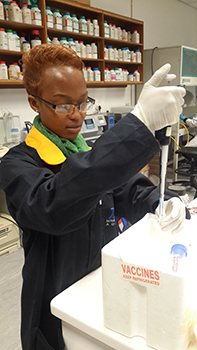 Reitumetse Maloa, postgraduate student and researcher at the UFS Department of Microbial, Biochemical and Food Biotechnology, is using her research to provide solutions to the energy crises in South Africa. |
A young researcher at the university is searching for the solution to South Africa’s energy and electricity problems from a rather unlikely source: cow dung.
“Cow dung could help us power South Africa,” explains Reitumetse Maloa, postgraduate student and researcher at the UFS Department of Microbial, Biochemical and Food Biotechnology.
Reitumetse’s research is trying to understand how the bacteria works that is responsible for producing biogas.
“Biogas can be used for cooking, heating, lighting and powering generators and turbines to make electricity. The remaining liquid effluent can fertilise crops, as it is high in nitrogen, phosphorus and potassium.”
By using cow dung and food waste to produce biogas, we will be able to lower greenhouse gases.
Biogas is produced in a digester - an oxygen-free space in which bacteria break down or digest organic material fed into the system. This process naturally produces biogas, which is mainly a mixture of methane and carbon dioxide.
“Many countries, such as Germany and the United States, have begun generating electricity from cow dung and food waste, through a process known as biogas production. In South Africa, a number of industries, including waste-water treatment facilities and farms, have caught on to this technology, using it to generate heat and to power machines.”
Until recently the world has relied heavily on electricity derived from fossil fuels such as coal, natural gas and oil. Once these fuels have been extracted from underground reservoirs, they are treated or cleaned, transported to power plants and transformed into the electricity that will reach your house. Fossil fuels are considered a ‘dirty’ energy source which gives off greenhouse gases when burned. Those gases are the major contributing factor to climate change.
“We know very little about the interaction of the bacteria inside the biogas digester. To use biogas as a sustainable fuel source, we need to understand and describe the bacteria population and growth dynamics inside the digester to produce biogas optimally. Currently we are testing a variety of feedstock, including bran, maize and molasses, for biogas production potential, as well as optimising the conditions leading to maximum biogas production. We are also exploring the potential to use the effluent as fertiliser on local farms. The ultimate goal is to have biogas systems that will supply our university with clean energy.”